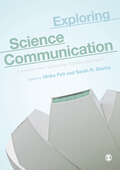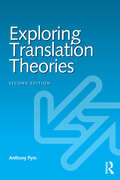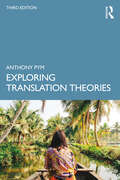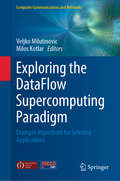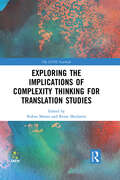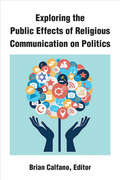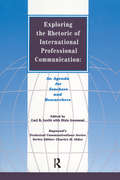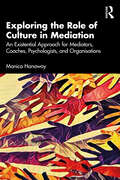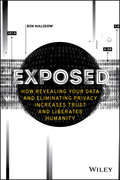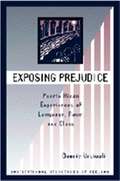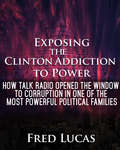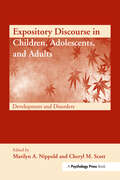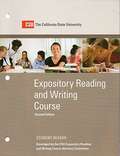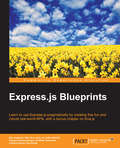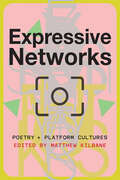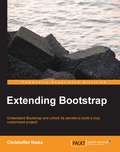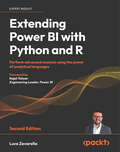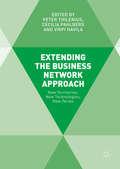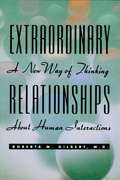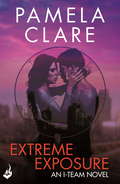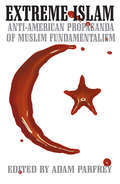- Table View
- List View
Exploring Science Communication: A Science and Technology Studies Approach
by Ulrike Felt Sarah R. DaviesExploring Science Communication demonstrates how science and technology studies approaches can be explicitly integrated into effective, powerful science communication research. Through a range of case studies, from climate change and public parks to Facebook, museums, and media coverage, it helps you to understand and analyse the complex and diverse ways science and society relate in today’s knowledge intensive environments. Notable features include: A focus on showing how to bring academic STS theory into your own science communication research Coverage of a range of topics and case studies illustrating different analyses and approaches Speaks to disciplines across Media & Communication, Science & Technology Studies, Health Sciences, Environmental Sciences and related areas. With this book you will learn how science communication can be more than just about disseminating facts to the public, but actually generative, leading to new understanding, research, and practices.
Exploring Science Communication: A Science and Technology Studies Approach
by Ulrike Felt Sarah R. DaviesExploring Science Communication demonstrates how science and technology studies approaches can be explicitly integrated into effective, powerful science communication research. Through a range of case studies, from climate change and public parks to Facebook, museums, and media coverage, it helps you to understand and analyse the complex and diverse ways science and society relate in today’s knowledge intensive environments. Notable features include: A focus on showing how to bring academic STS theory into your own science communication research Coverage of a range of topics and case studies illustrating different analyses and approaches Speaks to disciplines across Media & Communication, Science & Technology Studies, Health Sciences, Environmental Sciences and related areas. With this book you will learn how science communication can be more than just about disseminating facts to the public, but actually generative, leading to new understanding, research, and practices.
Exploring Translation Theories
by Anthony PymExploring Translation Theories presents a comprehensive analysis of the core contemporary paradigms of Western translation theory. The book covers theories of equivalence, purpose, description, uncertainty, localization, and cultural translation. This second edition adds coverage on new translation technologies, volunteer translators, non-lineal logic, mediation, Asian languages, and research on translators’ cognitive processes. Readers are encouraged to explore the various theories and consider their strengths, weaknesses, and implications for translation practice. The book concludes with a survey of the way translation is used as a model in postmodern cultural studies and sociologies, extending its scope beyond traditional Western notions. Features in each chapter include: An introduction outlining the main points, key concepts and illustrative examples. Examples drawn from a range of languages, although knowledge of no language other than English is assumed. Discussion points and suggested classroom activities. A chapter summary. This comprehensive and engaging book is ideal both for self-study and as a textbook for Translation theory courses within Translation Studies, Comparative Literature and Applied Linguistics.
Exploring Translation Theories
by Anthony PymExploring Translation Theories presents a comprehensive analysis of the core contemporary paradigms of Western translation theory. This engaging overview covers the key theories of equivalence, solution types, purpose, scientific approaches, uncertainty, automation, and cultural translation. Fully revised, this third edition adds coverage of Russian and Ukrainian theories, examples from Chinese, advances in machine translation, and research on translators’ cognitive processes. Readers are encouraged to explore the various theories and consider their strengths, weaknesses, and implications for translation practice. The book concludes with a survey of the way translation is used as a model in postmodern cultural studies and sociologies, extending its scope beyond traditional Western notions. Features in each chapter include: An introduction outlining the main points, key concepts and illustrative examples. Examples drawn from a range of languages, although knowledge of no language other than English is assumed. Discussion points and suggested classroom activities. A chapter summary. This comprehensive and engaging book is ideal both for self-study and as a textbook for Translation theory courses within Translation Studies, Comparative Literature and Applied Linguistics.
Exploring the DataFlow Supercomputing Paradigm: Example Algorithms for Selected Applications (Computer Communications and Networks)
by Veljko Milutinovic Milos KotlarThis useful text/reference describes the implementation of a varied selection of algorithms in the DataFlow paradigm, highlighting the exciting potential of DataFlow computing for applications in such areas as image understanding, biomedicine, physics simulation, and business.The mapping of additional algorithms onto the DataFlow architecture is also covered in the following Springer titles from the same team: DataFlow Supercomputing Essentials: Research, Development and Education, DataFlow Supercomputing Essentials: Algorithms, Applications and Implementations, and Guide to DataFlow Supercomputing.Topics and Features: introduces a novel method of graph partitioning for large graphs involving the construction of a skeleton graph; describes a cloud-supported web-based integrated development environment that can develop and run programs without DataFlow hardware owned by the user; showcases a new approach for the calculation of the extrema of functions in one dimension, by implementing the Golden Section Search algorithm; reviews algorithms for a DataFlow architecture that uses matrices and vectors as the underlying data structure; presents an algorithm for spherical code design, based on the variable repulsion force method; discusses the implementation of a face recognition application, using the DataFlow paradigm; proposes a method for region of interest-based image segmentation of mammogram images on high-performance reconfigurable DataFlow computers; surveys a diverse range of DataFlow applications in physics simulations, and investigates a DataFlow implementation of a Bitcoin mining algorithm.This unique volume will prove a valuable reference for researchers and programmers of DataFlow computing, and supercomputing in general. Graduate and advanced undergraduate students will also find that the book serves as an ideal supplementary text for courses on Data Mining, Microprocessor Systems, and VLSI Systems.
Exploring the Implications of Complexity Thinking for Translation Studies (The IATIS Yearbook)
by Kobus MaraisExploring the Implications of Complexity Thinking for Translation Studies considers the new link between translation studies and complexity thinking. Edited by leading scholars in this emerging field, the collection builds on and expands work done in complexity thinking in translation studies over the past decade. In this volume, the contributors address a variety of implications that this new approach holds for key concepts in Translation Studies such as source vs. target texts, translational units, authorship, translatorship, for research topics including translation data, machine translation, communities of practice, and for research methods such as constraints and the emergence of trajectories. The various chapters provide valuable information as to how research methods informed by complexity thinking can be applied in translation studies. Presenting theoretical and methodological contributions as well as case studies, this volume is of interest to advanced students, academics, and researchers in translation and interpreting studies, literary studies, and related areas.
Exploring the Public Effects of Religious Communication on Politics
by Brian CalfanoThough not all people are religious believers, religion has played important historic roles in developing political systems, parties, and policies—affecting believers and nonbelievers alike. This is particularly true in the United States, where scholars have devoted considerable attention to a variety of political phenomena at the intersection of religious belief and identity, including social movements, voting behavior, public opinion, and public policy. These outcomes are motivated by “identity boundary-making” among the religiously affiliated. The contributors to this volume examine two main factors that influence religious identity: the communication of religious ideas and the perceptions of people (including elites) in communicating said ideas. Exploring the Public Effects of Religious Communication on Politics examines an array of religious communication phenomena. These include the media’s role in furthering religious narratives about minority groups, religious strategies that interest groups use to advance their appeal, the variable strength of Islamophobia in cross-national contexts, what qualifies as an “evangelical” identity, and clergy representation of religious and institutional teachings. The volume also provides ways for readers to think about developing new insights into the influence religious communication has on political outcomes.
Exploring the Rhetoric of International Professional Communication: An Agenda for Teachers and Researchers (Baywood's Technical Communications)
by Carl R. Lovitt Dixie GoswamiPresents a collection of fourteen essays that responds to the need for a more rhetorical conception of professional communication as an international discipline. This book challenges the adequacy of relying on preconceived notions about the factors that determine discourse in international professional settings.
Exploring the Role of Culture in Mediation: An Existential Approach for Mediators, Coaches, Psychologists, and Organisations
by Monica HanawayThis new book explores the historical development of mediation (conflict resolution) from a cultural and existential perspective, and considers the cultural challenges involved for a mediator.The author, Monica Hanaway, has been mediating disputes across cultures for several years. She sets the scene for exploring the role culture plays in conflict and its resolution by explaining what mediation is and what we understand by the word ‘culture’. From there she explores what mediators need to keep in mind when considering culture in the context of mediation. Within this, she covers such topics as the merits of using interpreters, and the pros and cons of using mediators from the same culture as the disputants. The final section of the book comments on what mediation professional and training bodies need to do to raise the profile of the cultural aspects in conflict.Written by an experienced practitioner, Exploring the Role of Culture in Mediation will be of particular interest to all mediators, coaches, and psychologists, those interested in applying philosophy to resolving conflict, and those considering mediation.
Exposed: How Revealing Your Data and Eliminating Privacy Increases Trust and Liberates Humanity
by Ben MalisowDiscover why privacy is a counterproductive, if not obsolete, concept in this startling new book It's only a matter of time-- the modern notion of privacy is quickly evaporating because of technological advancement and social engagement. Whether we like it or not, all our actions and communications are going to be revealed for everyone to see. Exposed: How Revealing Your Data and Eliminating Privacy Increases Trust and Liberates Humanity takes a controversial and insightful look at the concept of privacy and persuasively argues that preparing for a post-private future is better than exacerbating the painful transition by attempting to delay the inevitable. Security expert and author Ben Malisow systematically dismantles common notions of privacy and explains how: Most arguments in favor of increased privacy are wrong Privacy in our personal lives leaves us more susceptible to being bullied or blackmailed Governmental and military privacy leads to an imbalance of power between citizen and state Military supremacy based on privacy is an obsolete concept Perfect for anyone interested in the currently raging debates about governmental, institutional, corporate, and personal privacy, and the proper balance between the public and the private, Exposed also belongs on the shelves of security practitioners and policymakers everywhere.
Exposing Prejudice
by Bonnie UrciuoliPuerto Ricans in the United States, like other migrant minorities, face an array of linguistic judgments. They are told they don’t succeed because they don’t speak English. They are told their English is "impure” or "broken” because it has been "mixed” with Spanish. They are told that they sound inarticulate and that if they speak "correct” English, with no sign of Spanish influence-most particularly with no accent, they will get better jobs. In short, Puerto Ricans in the United States are told that the origins of their economic and social problems are linguistic and can be remedied through personal effort, when in fact their fundamental problems stem from racial and class exclusion. Concepts like "mixed” or "broken” languages, and "good” and "bad” English are cultural constructions and therefore are about more than language. In the Puerto Rican experience of devaluation and prejudice in the United States, the institutionalization of racial exclusion and class location are mapped onto English and Spanish in complex and highly politicized ways. Formal linguistic studies of bilingualism rarely engage this process in a significant way. But the place, function, and meaning of cultural constructs within the politicized communicative economy must be understood in terms of the intersections of race, class, and language that shape the lives of working-class Puerto Ricans. Working from ethnographic studies and interviews done on New York’s Lower East Side and in the Bronx, this book examines that intersection in detail.
Exposing Prejudice
by Bonnie UrciuoliPuerto Ricans in the United States, like other migrant minorities, face an array of linguistic judgments. They are told they don't succeed because they don't speak English. They are told their English is "impure" or "broken" because it has been "mixed" with Spanish. They are told that they sound inarticulate and that if they speak "correct" English, with no sign of Spanish influence-most particularly with no accent, they will get better jobs. In short, Puerto Ricans in the United States are told that the origins of their economic and social problems are linguistic and can be remedied through personal effort, when in fact their fundamental problems stem from racial and class exclusion.Concepts like "mixed" or "broken" languages, and "good" and "bad" English are cultural constructions and therefore are about more than language. In the Puerto Rican experience of devaluation and prejudice in the United States, the institutionalization of racial exclusion and class location are mapped onto English and Spanish in complex and highly politicized ways. Formal linguistic studies of bilingualism rarely engage this process in a significant way. But the place, function, and meaning of cultural constructs within the politicized communicative economy must be understood in terms of the intersections of race, class, and language that shape the lives of working-class Puerto Ricans. Working from ethnographic studies and interviews done on New York's Lower East Side and in the Bronx, this book examines that intersection in detail.
Exposing Prejudice
by Bonnie UrciuoliPuerto Ricans in the United States, like other migrant minorities, face an array of linguistic judgments. They are told they don't succeed because they don't speak English. They are told their English is "impure" or "broken" because it has been "mixed" with Spanish. They are told that they sound inarticulate and that if they speak "correct" English, with no sign of Spanish influence-most particularly with no accent, they will get better jobs. In short, Puerto Ricans in the United States are told that the origins of their economic and social problems are linguistic and can be remedied through personal effort, when in fact their fundamental problems stem from racial and class exclusion.Concepts like "mixed" or "broken" languages, and "good" and "bad" English are cultural constructions and therefore are about more than language. In the Puerto Rican experience of devaluation and prejudice in the United States, the institutionalization of racial exclusion and class location are mapped onto English and Spanish in complex and highly politicized ways. Formal linguistic studies of bilingualism rarely engage this process in a significant way. But the place, function, and meaning of cultural constructs within the politicized communicative economy must be understood in terms of the intersections of race, class, and language that shape the lives of working-class Puerto Ricans. Working from ethnographic studies and interviews done on New York's Lower East Side and in the Bronx, this book examines that intersection in detail.
Exposing the Clinton Addiction to Power
by Fred LucasThe subject of FBI investigations and the leaders of the most controversial political organization in America, the Clintons have long been the subject of talk radio. Fred Lucas opens up those conversations that tore open the secrets currently being examined by the FBI. For those interested in the dynamics of Washington politics, the undercurrents of the Establishment and the lust for power that moves those who practice politics in Washington today, Fred Lucas brings those readers into the mix.
Expository Discourse in Children, Adolescents, and Adults: Development and Disorders (New Directions in Communication Disorders Research)
by Marilyn A. Nippold Cheryl M. ScottSchool success in the 21st century requires proficiency with expository discourse -- the use and understanding of informative language in spoken and written modalities. This occurs, for example, when high school students read their textbooks and listen to their teachers' lectures, and later are asked to demonstrate their knowledge of this complex topic through oral reports and essay examinations. Although many students are proficient with the expository genre, others struggle to meet these expectations. This book is designed to provide information on the use and understanding of expository discourse in school-age children, adolescents, and young adults. Recently, researchers from around the world have been investigating the development of this genre in typical students and in those with language disorders. Although many books have addressed the development of conversational and narrative discourse, by comparison, books devoted to the topic of expository discourse are sparse. This crossdisciplinary volume fills that gap in the literature and makes a unique contribution to the study of language development and disorders. It will be of interest to a range of professionals, including speech-language pathologists, teachers, linguists, and psychologists who are concerned with language development and disorders.
Expository Reading and Writing Course: Student Reader, Second Edition
by California State University (CSU) Expository Reading Writing Course Advisory CommitteeThe reading selections in this collection form the basis of the CSU Expository Reading and Writing Course (ERWC). The course is designed to foster critical thinking through a rhetorical approach to reading and writing.
Express.js Blueprints
by Ben AugartenThis book is for beginners to Node.js and also for those who are technically advanced. By the end of this book, every competent developer will have achieved expertise in building web applications with Express.js.
Expressive Networks: Poetry and Platform Cultures
by Matthew KilbaneExpressive Networks convenes an urgent conversation on digital media and the social life of contemporary poetry. Tracing how poems circulate through online spaces and how capitalized platforms have come to pattern the reading and writing of poetry, contributors emphasize both the expressivist cast of digital literary culture and the deep-running ambivalence that characterizes aesthetic and critical responses to platformed cultural production. The volume features chapters on Pan- African spoken word programs, Singaporean Facebook groups, decolonial hemispheric networks, and Japanese media-critical poetries as well as platforms such as Twitter/X, Instagram, and Amazon. Though contributors write from a variety of methodological positions and address themselves to a range of archives, they share the primary conviction that the impact of Web 2.0 on literary practice is far-reaching, far from self-evident, and far more variegated and unpredictable than easy summations of social media’s influence suggest. Expressive Networks asks after poetry’s present and future by examining what poems themselves express about the social make-up of networked platforms. Edited by Matthew Kilbane with contributions from Cameron Awkward-Rich, Micah Bateman, Andrew Campana, Sumita Chakraborty, Scott Challener, C.R. Grimmer, Tess McNulty, Michael Nardone, Seth Perlow, Anna Preus, Susanna Sacks, Carly Schnitzler, Melanie Walsh, and Samuel Caleb Wee.
Extending Bootstrap
by Christoffer NiskaPractical and instruction-based, this concise book will take you from understanding what Bootstrap is, to creating your own Bootstrap theme in no time! If you are an intermediate front-end developer or designer who wants to learn the secrets of Bootstrap, this book is perfect for you.
Extending Power BI with Python and R: Perform advanced analysis using the power of analytical languages
by Luca ZavarellaIngest, transform, manipulate, and visualize your data beyond Power BI's capabilities. Purchase of the print or Kindle book includes a free eBook in PDF format.Key FeaturesDiscover best practices for using Python and R in Power BI by implementing non-trivial codeEnrich your Power BI dashboards using external APIs and machine learning modelsCreate any visualization, as complex as you want, using Python and R scriptsBook DescriptionThe latest edition of this book delves deep into advanced analytics, focusing on enhancing Python and R proficiency within Power BI. New chapters cover optimizing Python and R settings, utilizing Intel's Math Kernel Library (MKL) for performance boosts, and addressing integration challenges. Techniques for managing large datasets beyond available RAM, employing the Parquet data format, and advanced fuzzy matching algorithms are explored. Additionally, it discusses leveraging SQL Server Language Extensions to overcome traditional Python and R limitations in Power BI. It also helps in crafting sophisticated visualizations using the Grammar of Graphics in both R and Python. This Power BI book will help you master data validation with regular expressions, import data from diverse sources, and apply advanced algorithms for transformation. You'll learn how to safeguard personal data in Power BI with techniques like pseudonymization, anonymization, and data masking. You'll also get to grips with the key statistical features of datasets by plotting multiple visual graphs in the process of building a machine learning model. The book will guide you on utilizing external APIs for enrichment, enhancing I/O performance, and leveraging Python and R for analysis. You'll reinforce your learning with questions at the end of each chapter.What you will learnConfigure optimal integration of Python and R with Power BIPerform complex data manipulations not possible by default in Power BIBoost Power BI logging and loading large datasetsExtract insights from your data using algorithms like linear optimizationCalculate string distances and learn how to use them for probabilistic fuzzy matchingHandle outliers and missing values for multivariate and time-series dataApply Exploratory Data Analysis in Power BI with RLearn to use Grammar of Graphics in PythonWho this book is forThis book is for business analysts, business intelligence professionals, and data scientists who already use Microsoft Power BI and want to add more value to their analysis using Python and R. Working knowledge of Power BI is required to make the most of this book. Basic knowledge of Python and R will also be helpful.
Extending the Business Network Approach
by Peter Thilenius Cecilia Pahlberg Virpi HavilaContributing pioneering new research, this innovative book proposes newways and directions in which to extend the influential 'business networksperspective' approach to doing business. While previous research has focusedupon relationships with customers and suppliers, the authors argue that thereis a need to expand the outlook to include other stakeholders. Taking a standin a broad management perspective, chapters relate contemporary issues withinindustrial and international marketing, product innovation, and informationsystems. Challenging existing views and proposing elaborate alternatives; thisvolume examines a range of examples that have inspired researchers to extendthe business network. To provide further understanding, Extending the Business Network Approach relates current and newresearch to territories, technologies and terms to reveal novel insights, andto encourage further directions for research.
Extraordinary Relationships: A New Way of Thinking about Human Interactions
by Roberta M. GilbertTurn any Relationship into an Extraordinary Relationship "A refreshing alternative to common self-help approaches. " -Michael E. Kerr, M. D. , Director, Georgetown Family Center, Washington, D. C. and coauthor with Dr. Murray Bowen of Family Evaluation After food, water, and shelter, relationships are the most important factors in determining your quality of life. At work, productivity and efficiency depend on relationships. At home, relationships with your spouse, children, and friends are keys to success and happiness. And among nations, relationships start and stop wars. This invaluable guide shows that only by further developing yourself can you further develop your relationships. Based on the innovative family systems theory pioneered by the late Dr. Murray Bowen, this important and penetrating book offers practical and authoritative family therapy advice that has helped thousands of people throughout the last three decades. It's a blueprint to better relationships that tells how the principles of family systems theory can be used in all arenas of your life, including intimate relationships, friendships, family relationships, single life, workplace relationships, international relationships, and your relationship with yourself. "A perfect and unpretentious primer of family relationships . . . a relief to read. " -Dr. Walter Toman, Professor Emeritus, Erlangen-N8rnberg University, Germany, and author of Family Constellation
Extreme Exposure: I-Team 1 (I-Team #1)
by Pamela ClareFans of Suzanne Brockmann, Maya Banks, Christy Reece, Julie Ann Walker and Cindy Gerard will adore Pamela Clare's expertly plotted romantic suspense series, which sets the pages alight with sizzling chemistry. For tension, thrills, romance and passion take a spin with the I-Team.In the years since her child's father left her, Kara McMillan has kept men at bay. The hard-boiled journalist has vowed never to become vulnerable again, however lonely she feels. With his dangerous good looks, charm and power, Senator Reece Sheridan could have just about any woman he sets his piercing eyes on. But he's intrigued by only one: gutsy, sensual reporter Kara, who promises to be every bit the firebrand in bed that she is in print. But this is no fling. A sudden political scandal - and attempts on Kara's life - threaten to drive them apart. Yet maybe adversity will draw them into a bond even more intense than their steamy embraces...Sexy. Thrilling. Unputdownable. Take a wildly romantic ride with Pamela Clare's I-Team: Extreme Exposure, Hard Evidence, Unlawful Contact, Naked Edge, Breaking Point, Striking Distance, Seduction Game.
Extreme Islam
by Adam Parfrey"Here is a window inside the Jihad... presented here in its bare face without a distorting commentary."--Jeremy Glover, Headpress"(C)ontains essays and fascinating images that will render you serious, humbled and even a bit sympathetic... Extreme Islam's deranged carnival succeeds in shocking most when the 'extremists' themselves are lucid, poignant and poetic."--R.U. Sirius, LA Weekly
Extremum-Seeking Control and Applications
by Chunlei Zhang Raúl OrdóñezExtremum-seeking control tracks a varying maximum or minimum in a performance function such as output or cost. It attempts to determine the optimal performance of a control system as it operates, thereby reducing downtime and the need for system analysis. Extremum-seeking Control and Applications is divided into two parts. In the first, the authors review existing analog-optimization-based extremum-seeking control including gradient-, perturbation- and sliding-mode-based control designs. They then propose a novel numerical-optimization-based extremum-seeking control based on optimization algorithms and state regulation. This control design is developed for simple linear time-invariant systems and then extended for a class of feedback linearizable nonlinear systems. The two main optimization algorithms - line search and trust region methods - are analyzed for robustness. Finite-time and asymptotic state regulators are put forward for linear and nonlinear systems respectively. Further design flexibility is achieved using the robustness results of the optimization algorithms and the asymptotic state regulator by which existing nonlinear adaptive control techniques can be introduced for robust design. The approach used is easier to implement and tends to be more robust than those that use perturbation-based extremum-seeking control. The second part of the book deals with a variety of applications of extremum-seeking control: a comparative study of extremum-seeking control schemes in antilock braking system design; source seeking, formation control, collision and obstacle avoidance for groups of autonomous agents; mobile radar networks; and impedance matching. MATLAB®/Simulink® code which can be downloaded from www.springer.com/ISBN helps readers to reproduce the results presented in the text and gives them a head start for implementing the algorithms in their own applications. Extremum-seeking Control and Applications will interest academics and graduate students working in control, and industrial practitioners from a variety of backgrounds: systems, automotive, aerospace, communications, semiconductor and chemical engineering.
